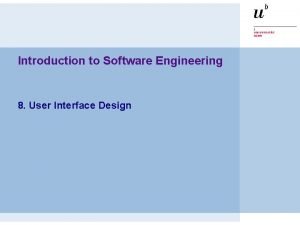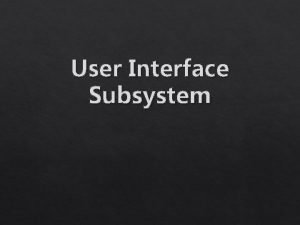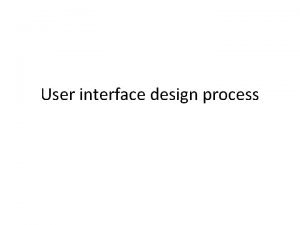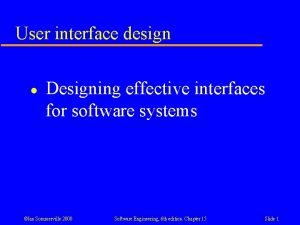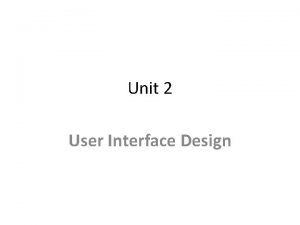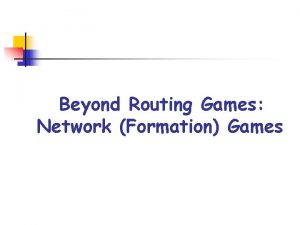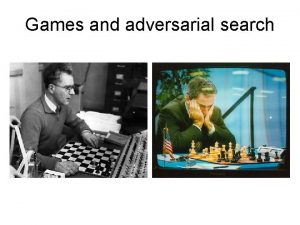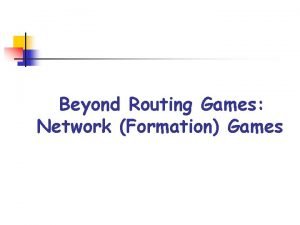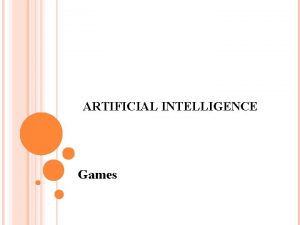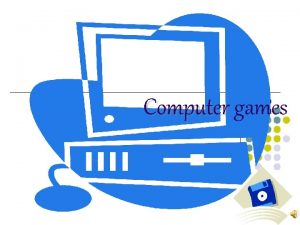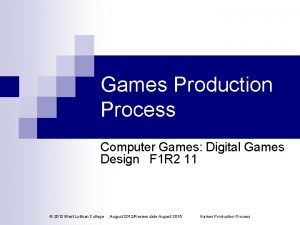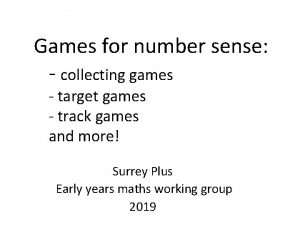User Interface in Games Principles of User Interface



















- Slides: 19

User Interface in Games

Principles of User Interface Design • Know your user's tasks • Craft an interface suitable to the user and the user's tasks that: • • Reduces memory demands Encourages exploration Automates menial tasks Supports novice and expert users • Do these things apply to games?

Know Your User • Can we make any generalization about gamers? • Technical level? • Gender? • Other?

Know Your User • According to surveys, the largest demographic of online game players are middle aged women • Cards • Puzzles • Instead of generalizations, we need to consider the users for particular games • Elderly • Children • “Stereotypical” gamers

Know Your Users • Bartle's Taxonomy: different types of users in “MUDs” • • Achiever – get to the “high levels” of the game Explorer – see all the content Killer – proving one’s self superior to other players Socializer – just being around / talking to other players • Many players fall into multiple categories

Know Your User's Tasks • Tasks will vary per game • For example, what are the tasks: • in a puzzle game? • in a RTS? • in an MMO? • Multi-player games are interesting, as they combine aspects of instant messaging with other gameplay aspects • Communication is often a necessary task

User's Tasks • In most applications, tasks are things that a user is using the software for, i. e. a goal to be accomplished • In a game, tasks are effectively artificial, created by the game designers • Tasks in a game are effectively what the game is about, the 'game play‘ • What's the difference between game play and UI?

Game Play vs User Interface • Not a clean distinction between these concepts • Game play: what the game lets you do (features) • UI: how you do certain things • Sometimes they are the same thing • a targeting reticule on a shooter • Sometimes they are not • ability to right-click on an object and get a menu

Game Play vs User Interface • A deeper example of this is the crafting system in Ever. Quest • Ability for players to create in-game items • First version of the interface violated many UI principles: • High memory requirements on user • Very tedious, lots of repetitive clicking • Did not encourage exploration • Combining items incorrectly would get them eaten

Game Play vs User Interface • Old-style EQ trade skills

Game Play vs User Interface • Newer versions of the interface addressed many of these issues • Lists of known recipies • Automatically removing items from inventory • Not destroying invalid combinations of items • Same in-game mechanism, better UI support

Game Play vs User Interface • New EQ trade skills

Immersion vs Interface • Sometimes the 'traditional parts' of the GUI are part of the game • Flight sims • In a true 'first person' view, might not be a HUD • Halflife 2 • Does altering the reality too much break the immersion? • Visual cues that an object can be interacted with that aren’t there in the “real world”

Multi-level Interfaces • • Interfaces that accommodate both novice and expert users In most apps, the UI facilitates the app's tasks In games, the UI is also there to challenge the user Often, short cuts that a novice user might use are required to be an "expert" user • Hotkeying production sites in an RTS • In-game macro commands ("/group Attacking $target") • You might have to “raise yourself” to the level of the UI, instead of the other way around!

Case Study: City of Heroes • One of the more popular MMOs on the market today • Super hero genre, very different from the majority of fantasy-based games • A good example of HCI principles applied to a game • Demographic: surprising number of couples play together • Significant others • Father/son

Co. H Design Principles • City of Heroes followed many good UI design practices: • Make the obvious choices for a user automatically and let them fix it if they want to. • Don't let the user make a error. • Make common things obvious and trivially easy to do. • Make uncommon things as easy as possible to do, but don't sacrifice the usability of common things to do so. • Minimize surprise, let the user make educated decisions

Co. H Tasks • Primary tasks, mapped to keyboard • Movement • Combat • Secondary tasks, mapped to right-click menus • Interaction with other people • Other: managing inventory, setting game options

Co. H UI Principles • Error Prevention • Always better to prevent errors before they happen • In the enhancement screen, powers that won't accept the enhancements are insensitive (grayed out) • City of Heroes actually doesn't contain error dialog boxes • Errors from the /command language still occur and are dealt with

Co. H UI Principles • User-centered control of information • Chat screens allow filtering of what channels are displayed • Multi-level interfaces • Mission difficulty level can be set by an in-game mechanism • Story related, as to try to keep the level of immersion high • Keyboard "slash commands" and macros • As game user interfaces go, the City of Heroes team did a superb job
 Guidelines for data entry screen design
Guidelines for data entry screen design Principles of user interface design
Principles of user interface design User interface design in software engineering
User interface design in software engineering The hunger games chapter 23 questions and answers
The hunger games chapter 23 questions and answers Types of games outdoor
Types of games outdoor Interface in java
Interface in java Fluidity in hci
Fluidity in hci Industrial interfaces
Industrial interfaces An interface
An interface Yahoo user interface
Yahoo user interface What is xul
What is xul Graphical user interface testing
Graphical user interface testing User interface subsystem
User interface subsystem Interface design diagram
Interface design diagram User interface design cycle
User interface design cycle Importance of user interface
Importance of user interface User interface in software engineering
User interface in software engineering User interface analysis and design
User interface analysis and design Touch screen technology seminar
Touch screen technology seminar Characteristics of graphical user interface
Characteristics of graphical user interface


